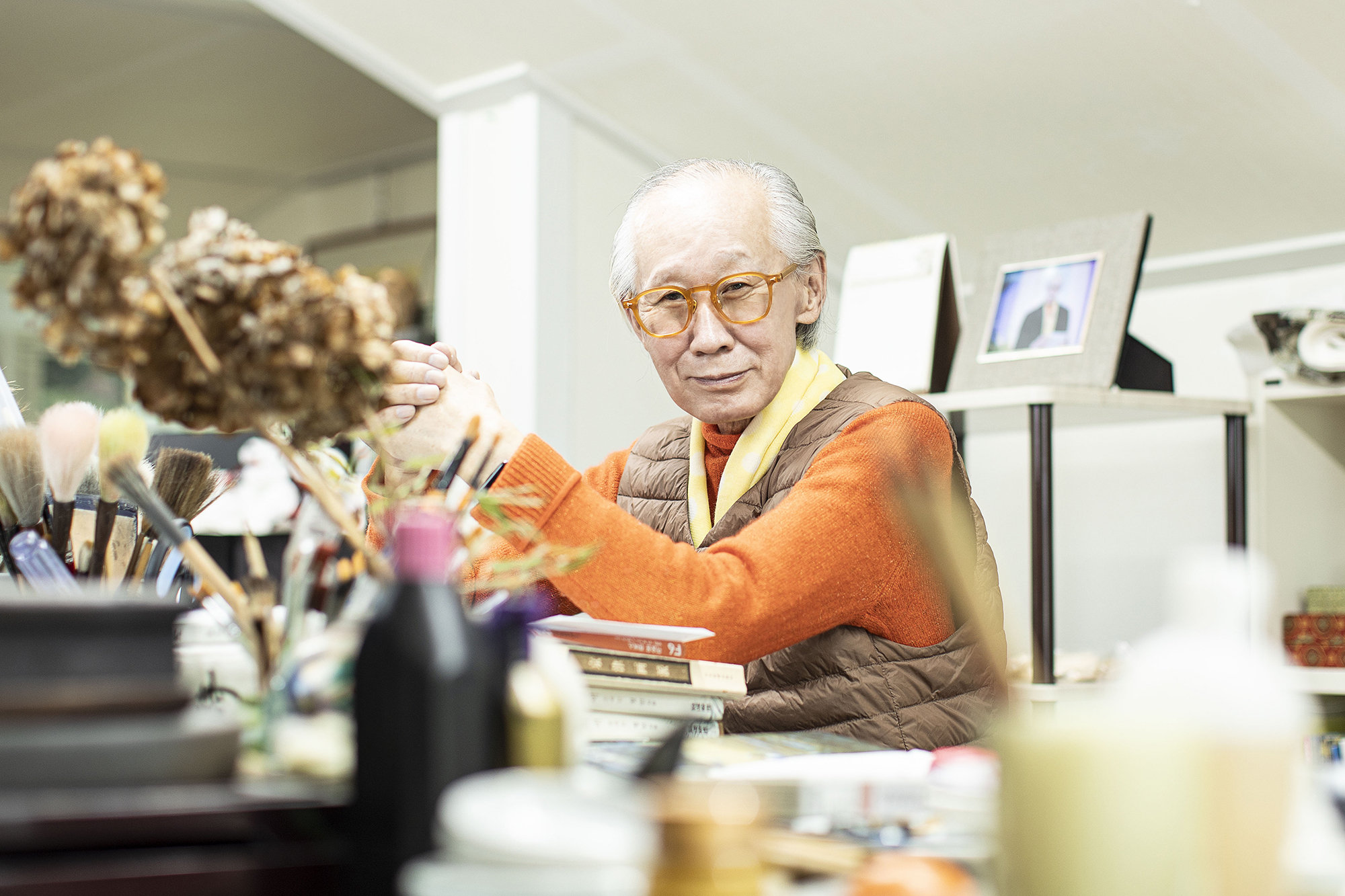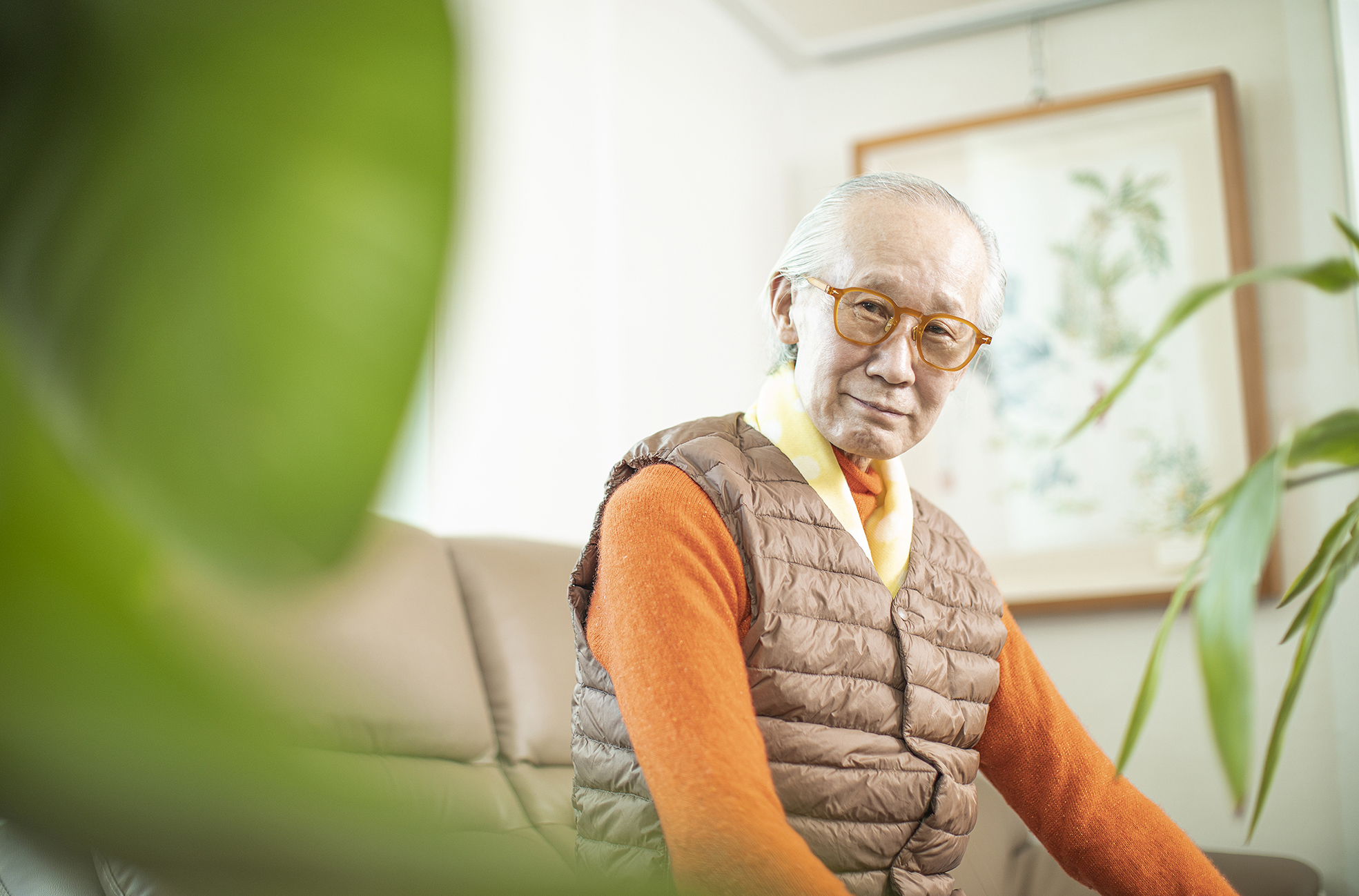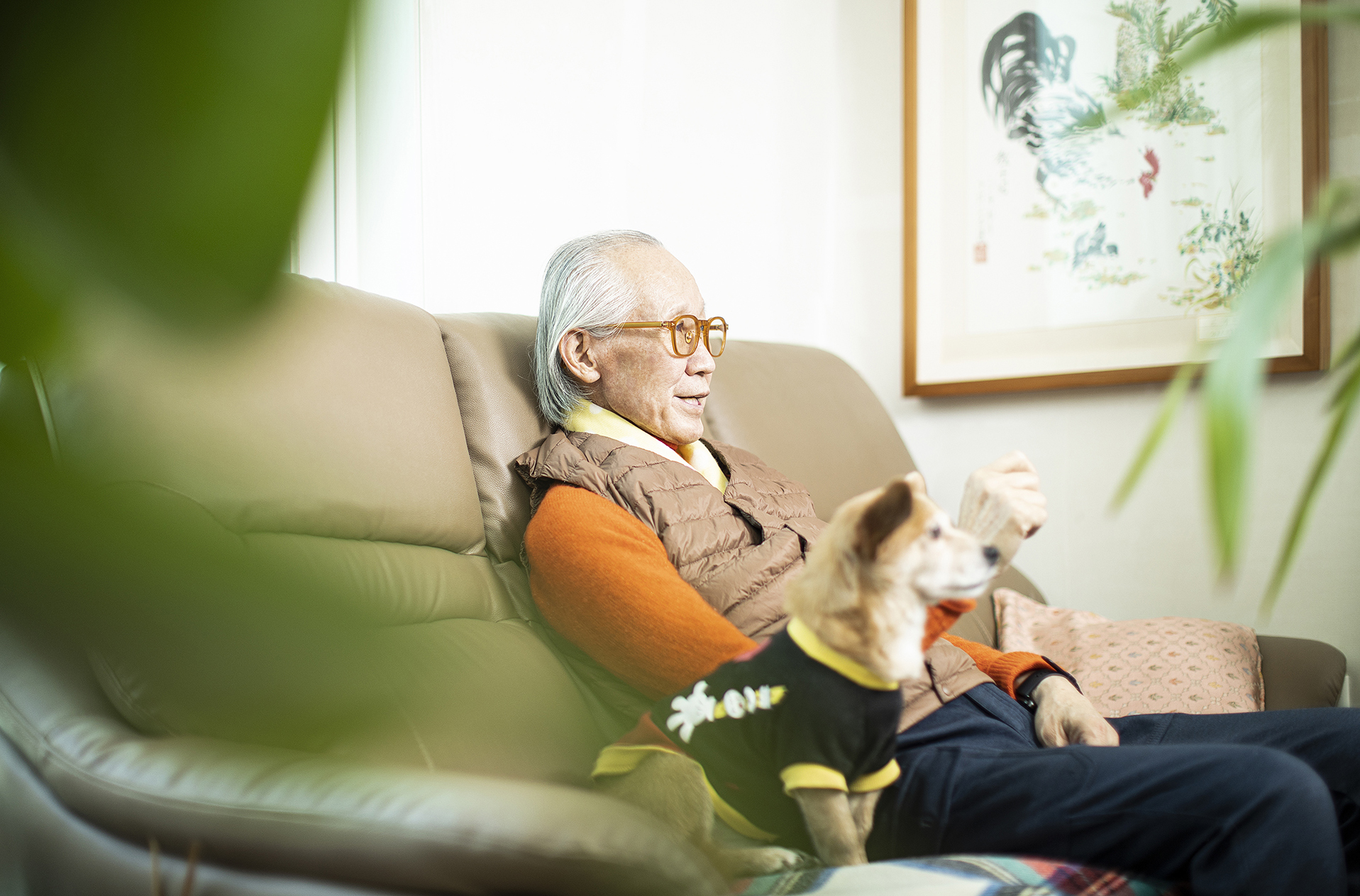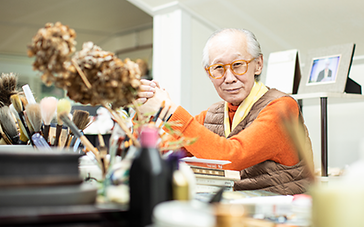- 'Youth' on the Canvas of Life July 25, 2023
-
Alumnus Ahn Chang-soo (Dept. of Economics, Class of ‘65), Living His Second Life as an Eastern-Style Painter.

Act 2: Becoming a Master of Eastern-Style Painting
When thinking about retirement life after spending decades at work, most of us dream of leisurely time away from the front lines of the workplace. For most of us, retirement is a time to prepare for the end of life in peace rather than the beginning of a new chapter. However, some find themselves entering a brand-new chapter of their lives, discovering their youth with renewed enthusiasm, and alumnus Ahn Chang-soo is one of those adventurous minorities. After a 30-year career in finance, Ahn's retirement at the age of sixty marked the beginning of his pursuit in Eastern-style painting. Recognized as one of the world's leading Eastern-style painters for his unique work, Ahn is full of uninterrupted passion in every moment of his life, unbounded by age. Even now, he is filling the canvas of his life with the most dynamic brushstrokes and the most vibrant colors.
The World of Eastern-style Art After Retirement, Studying Abroad in His 60s
"I spent 30 years in finance, working at the Export-Import Bank analyzing the economic landscape of countries around the world, working in international cooperation, official development assistance, etc. After retiring at 58, I returned to my hometown in Yangsan as an advisor to Daewoo Shipbuilding & Marine Engineering. After returning home, I sought joy in my retirement life by occasionally hanging out with friends. Then I met a life-long companion, who changed my life. It was none other than Eastern-style art.
At first glance, one might assume that Ahn would have been interested in Eastern-style art as a childhood hobby for years before his retirement, but throughout his life, he never felt that he had a particular taste for art. He did not dream of becoming an artist or recognize his hidden talent. Contrary to what most would think, Ahn was an exemplary student admitted to a prestigious high school to enter Yonsei eventually, and even during his campus life, he was a diligent student who would spend most of his time in lecture halls or the library.
Ahn’s first encounter with Eastern-style art was purely coincidental; as he was looking for trivial things to do amidst his sedentary retirement life, he began reading the Buddhist sutras which eventually led him to learn calligraphy at the suggestion of an acquaintance to copy the writings of the sutras. About six months after learning calligraphy, Ahn happened to visit a rooster painting exhibition in Busan, and as he drew paintings of roosters to mark the year of the rooster, they were surprisingly well-received. He also received request after request for his paintings. Such an unexpected response made him wonder if he truly had a talent for painting. It also gave him the desire to learn to paint formally. In 2005, at the age of 60, Ahn embarked on a new path, into the world of Eastern-style painting.
"I wanted to see if I really had the talent. I wanted to be recognized for my talent and learn to draw properly. I was recommended that the best place to study Eastern-style art is Hangzhou Chinese Academy of Fine Arts, renowned for its long history in China. Full of hope, I went to China with just a backpack. Without anything prepared, I visited the professors to be granted the opportunity to study there, and one of the professors saw my drawings and wrote a letter of recommendation, which allowed me to be accepted as a foreign research student. I was impatient because I started late. To build my skills, I used to stay up late drawing until my fingers were numb while commuting back and forth from my dorm and school. It took a lot more effort because I didn't pursue this path from a young age like everyone else in art school."Discovery of Talent, Coupled with an Unrelenting Passion
Ahn's wife, who initially wanted a stable retirement life for him like everyone else, supported his decision to study abroad, saying, "You're the kind of person who, when you set your mind to something, follows through." She was right, considering how Ahn was so determined that he did not visit Korea for two years for fear of interrupting the flow of his learning. Just a few months after he started painting earnestly, Ahn entered a painting contest for foreigners organized by the school and won. It was not only the result of hard work but also the result of confronting the prejudices of people who were sometimes surprised or skeptical of him learning to draw at such a late age. It gave him the well-needed courage. Ahn began investing more time into painting, improving his skills by the day. Subsequently, he won awards such as the first prize at the 2006 Chinese National Calligraphy Art Competition and the gold medal at the National Calligraphy Art Competition of China. Though he managed to win numerous awards, beginning his journey as an artist at a late age, Ahn constantly had questions in his mind- "How far can I achieve in this field?" and "Until when should I continue learning?" It was then that he turned to his professor for advice.
"I consulted my professor and asked him, 'Can I continue to pursue this path at my age?' And the professor said 'yes'. He told me that a Chinese painter named Jin Nong first picked up a brush at the age of fifty and started painting bamboo when he was past the age of sixty. However, he became the greatest painter of the Qing Dynasty. There was also Grandma Moses, an American painter, who was much loved as a national painter, even though she started painting when she was well past her seventies. My professor encouraged me that two years of learning is all it takes to harness the foundational skills, but how far one can go as an artist entirely depends on how much effort I put in, and his words gave me the conviction that there is no need to have such self-doubts. It was a huge source of motivation."
After two years of studying abroad in China, Ahn packed his backpack to study in Japan. He had the desire to learn paintings from all three countries in East Asia, and most importantly, he wanted to see the trend of global Eastern-style art in Japan, where he could quickly see the changes in Eastern-style art and create a work that was not limited to tradition but was broader and more open. Fortunately, with Ahn having experience living in Japan for four years during his days at Export-Import Bank, the language barrier and the different lifestyle in Japan did not come as challenges to him. Just a month after his return to Korea after completing his studies in China, Ahn enrolled at the Kyoto University of Arts & Design. Visiting the museums and art galleries countless times in Japan, he exposed himself to great paintings to learn from them. As his solid artistic foundation from China met with a broadened perspective and breadth of experience in Japan, it added depth to his artworks. Just like his time in China, Ahn also won numerous competitions in Japan. Following two entries in the Sowha Competition, he was awarded one of the most prestigious prizes in the Japan National Ink Painting Competition, the Foreign Minister's Award. Since this was the first time a Korean had won this award, it marked a milestone in Korean Eastern-style art. After returning to Korea, Ahn won the Grand Prize at Shin Saimdang Art Contest and other prestigious art competitions in Korea, proving that he has grown into a world-class artist. Although he started Eastern-style painting at the age of sixty, his youthful enthusiasm allowed him to achieve these feats in just three years. The second act of his life unfolded like that, on another worldly path, making its own signposts.
Eastern-Style Paintings with Delicacy and Vibrancy
Ahn held his first exhibition in 2009, showcasing more than 40 works. His work almost immediately received attention within the field. Ahn's works mainly revolve around animal and floral drawings. From roosters to include eagles, tigers, horses, dragons, lotus flowers, and plum blossoms, the subjects of his art are diverse. Using fast and powerful strokes in animal paintings and delicate strokes in floral paintings, and his style varies depending on the subject. One critic would describe his work as "works that are based on tradition, to express modernity through sensuous penmanship and expression. Ahn uses ink as the basis, but he adds dazzling changes through the use of color and sensual expressions of the subject.
What is interesting is the bold and decisive strokes, which quickly outline the subject and reflect a sense of speed and lightness compared to the heavy, dull, and slow style of traditional calligraphy." As a painter, Ahn agrees that this is a critique that well-penetrates his artworks.
"When I was learning to draw, I trained to draw fast and a lot. I probably drew it three times faster than anyone else. While studying abroad, one of my professors would remind me to draw slowly occasionally. I tried to, but it just didn't work for me. There's a Chinese artist named Xie Xiyong who is famous for his horse paintings. It was said that the artist would draw at such a fast pace that an ordinary man's eyes could not follow his brushstrokes. The dean of the art school brought up that tale as he encouraged me to draw however I wish to draw, and that's what I did (Laughs). It is thus natural to see such stroke styles reflected in my works. In fact, drawing fast and a lot is what allowed me to become skilled."
Ahn is also renowned as a prolific artist because he can draw faster than anyone else. He would hold his exhibitions once or twice a year to exhibit his work to the public. So far, he has already held 18 exhibitions, but his studio is still full of artworks and projects of all sizes.
While he is known for his sensuous painting style, with delicate, colorful brushstrokes that reveal the beauty of ink coloring, Ahn has a great reputation for his animal paintings, marked by his brushstrokes that reflect strength and joviality. In particular, his tiger-themed paintings are known to be one of a kind. The vibrancy of the tiger is awe-inspiring, as it seems to come alive on the canvas. Over the years, Ahn has held 13 tiger painting exhibitions, and in 2018, the Baekdudaegan National Arboretum invited him to hold a special collection of his tiger-themed works. The eagle, a symbol of Yonsei, is also special to him. In particular, in 2012, Ahn's eagle painting was hung in the Jamsil main stadium as a large banner painting in the Yon-Ko game. The painting of an eagle soaring in the air made the cheering of Yonseians even more intense, and receiving a plaque of appreciation from the alum association was indeed a meaningful memory for him. In 2019, he donated the artwork for the cover of a booklet commemorating the 50th class reunion. In 2013, he was awarded the 'Proud Yonseian Award' by the Yonsei Alumni Association. In 2018, he was awarded the 'Proud Korean Award' as an Eastern-style painter representing South Korea, again bringing glory to the Yonsei alumni

(Photo courtesy of Artwork : Alumnis Ahn Chan-soo)
Breaking Out of the Norm to be Filled with New Inspirations.
Alumnus Changsoo Ahn, who used to focus on animal and flower paintings, is now focusing on 'Korean portrait and landscape art (San-su hwa)'. Even for San-su hwa, Ahn strives to create his own world within the canvas.
"I'm wary of painting a picture that's stuck in the past. You know, the typical picture that comes to mind when you think of San-su hwa. Something like an older man standing around in a robe comes to mind. I'm not interested in those paintings. I think it should be newer and more polished."
Always looking for something new, he wants to be inspired by more than just one thing. Naturally, the spectrum of artists from whom Ahn gets inspiration is also wide. But it is just not enough to observe the strengths of different painters, as well as the techniques he wants to pick up. It is solely through countless practices that enables him to completely materialize them as his own skills. Ahn's unique artworks are the fruit of such dedication and hard work.
"The truth is, there are different aspects from which I hope to learn for the respective artworks I encounter. When I am drawing one thing, I seek to learn from this artist's technique, and when I am drawing another subject, I get inspired by another artist's technique. And of course, there are artworks where I would follow the popular trend like all the other artists as if there is one single answer available. For those works, I feel like I'm being lazy as an artist and that there's a limit to how much good work can come from pulling an all-nighter like that. In retrospect, I think one can acquire the desired depth and maturity as an artist when one builds a foundation by trying out new things through various adventurous attempts and then focusing on one in earnest. I might have started 'drawing' San-su hwa, but I'm not technically there yet. There's still so much to learn on so many fronts, and I think there is a need to work hard to really get started."
Just as he opened a new chapter in his life by studying abroad in China at the age of 60, Ahn pursued a life as vibrant and dynamic as his canvas rather than a life of stagnation and complacency. His life has always been about embracing newness and using it as a source of nourishment, as reflected in his artwork.To Create Artworks With Depth and Immersion
Alumnus Changsoo Ahn is also passionate about donating his work. His artworks have been presented to government offices such as city halls, bringing charm and beauty to the public. Sometimes he would sell them at charity bazaars and donate the proceeds. He seeks to help enrich the lives of the community instead of being trapped in the confines of his own workspace.
He is also planning to hold an exhibition this year. In addition to the exhibition proposed by the Export-Import Bank, there is also an ongoing discussion with Haeinsa for another potential exhibition. As of now, Ahn seeks to add depth by narrowing down the subjects and managing his pace.
"I want to cut down on the subjects I deal with and go deeper. I've been feeling a little unwell for the past year, and it's been hard for me to draw as fast as I used to. Back when I used to draw fast, I would normally finish a piece in one sitting. However, lately, I've been incorporating a new method: draw for an hour, take a short break, and resume drawing again. Fortunately, I've received positive feedback that my paintings' quality has improved. As I take time with my painting, I can detect the mistakes I make, and I am now looking at my works more objectively. I am planning to be less prolific to be more focused on the subject and each piece to add depth instead."Something Life-changing, Something ‘Fun that I can Excel’
For alumnus Ahn Chang-soo, the second act of his life with Eastern-style painting brings new meaning and joy to his life. He found something he could do well, something he enjoyed and was passionate about. This would have been something he wouldn't have been able to do if he'd settled for a life of freedom after retiring as a banker. Living a life as an artist in the later chapter of his life was not something he anticipated, and he doesn't want anyone to give up on this aspect of surprise in life.
"Sometimes you don't know what your talents are or what you enjoy doing. But as you live your life, you find some fun jobs, and among them, you find things you can excel in. It's important to find these things as quickly as possible. To do that, you need to constantly try different things you're interested in, rather than doing something 'presentable'. If you love painting, you have to go to galleries, see exhibitions, and keep trying to learn from them. That's how you explore what you love to do. I would say that finding something like that and working on it quickly is a must, whether you're preparing for a career or planning for the second act of your life after retirement."
For Ahn, even at this moment, he never stops working on things that bring him new joy. Since 2007, he has also been making another transformation as a senior actor, appearing in commercials and movies. Using his Japanese language skills, he played the role of a Japanese official in the film "Anarchist from Colony" by Director Lee Joon-ik, while appearing in a public campaign commercial. The new adventure as an actor has become a new source of rejuvenation for Ahn. With the new aspiration to become an actor, he plans to pursue his passion at every chance.
Alumnus Ahn Chang-soo's art name is "Seolpa," that is, 'Snow Wave'. As Ahn watched the snowflakes becoming one with the midwinter wind in the temple where he studied as a child, he had the determination to overcome whatever obstacles he faces in life, just like the snowflakes that form waves instead of being blown away. His art name, "Seolpa", was something that he reminisced about when he first began learning Eastern-style art, and it seems to best represent Ahn's life and his works that do not fear new challenges, being uncompromising and pioneering. As such experiences accumulate, he is living in the second act of his life as a master of Eastern-style painting, unfolding a beautiful world on the canvas of his life.
show mobile menu
mobile menu




